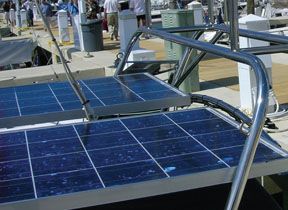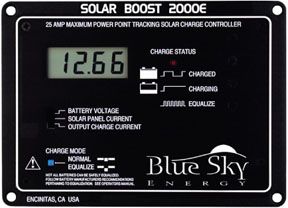
]If someone walked up to you at a boat show and offered to sell you a black box that would increase the output of your solar panels by 30 percent you might still be laughing-but were talking about an MPPT (Maximum Power Point Tracking) solar panel charge regulator, and its real.
A charge regulator really has only two functions on a solar panel: to block a small reverse current flow back into the panels at night and to regulate the voltage to prevent overcharging. Before MPPT came around, existing types of regulators-even sophisticated pulse width modulation (PWM) regulators-failed to address a problem unique to charging batteries with solar panels. Solar panel output current remains relatively constant over a wide range of operating voltages.
A typical 80-watt panel has an operating voltage of 17.8 volts that delivers 4.5 amps (watts = volts x amps) in industry standard conditions. This is the Maximum Power Point (MPP) for this panel. However, when the solar panel is connected to a battery bank-either through a regulator or directly-the panels operating voltage is pulled down to something near the voltage of the battery bank, yet the charging current-4.5 amps-remains the same. Under these conditions, 60 watts (12.2 volts x 4.5 amps) is the maximum charging power the batteries will ever receive from the 80-watt solar panel. If the battery voltage is lower, even less power will be available to charge the battery bank.
A Maximum Power Point Tracking regulator finds and tracks the MPP for the prevailing conditions, which in turn determines the best operating voltage for the panel. Then, while the optimum panel voltage is maintained, a voltage converter lowers the output voltage before sending it on to the batteries. The charging voltage, after conversion, would vary with battery condition, but for our purposes well use 12.6 volts.
The full 80 watts is being delivered by the panel, so excluding losses, the battery would be receiving approximately 6.3 amps (80 watts 12.6 volts) of charging current, about a 40 percent increase in charging current.
These numbers arent necessarily real world. Circuit losses have not been subtracted and several variables influence the ability of an MPPT regulator to increase charging current. Lower battery voltage (discharged), lower panel temperatures (wind helps), and hazy sky conditions increase the percentage gained, but a clear, hot day coupled with high battery voltage (almost charged) can also lower it significantly. It might be possible to see a 40 percent increase in charging current on a cold winter day with discharged batteries, but a 15 to 30 percent increase is more typical.
PS recently served as a qualified bystander, the kind you love to hate, during the installation of a Blue Skies Solar Boost 2000 ($236) regulator driven by two identical, 80-watt solar panels on a boat. We also installed a Blue Sky SB3024i ($299) MPPT regulator and two 80-watt solar panels on one of our contributors Mason 43.
Solar Boost 2000
The Solar Boost 2000 is a 12-volt, 25-amp MPPT charge regulator that employs pulse width modulation to regulate the battery charge. Its a two-stage regulator that operates at the maximum possible charge rate (bulk mode) until a voltage set point is reached, and then it reverts to the second stage and charges at a constant voltage. Voltage set points are user-adjustable, and a manually activated equalization mode is part of the design. The unit includes an LCD monitor to view battery voltage plus charging current, both into and out of the regulator, letting you see the amount of current boost achieved by the regulator at any given moment. Nice features include automatic current limiting at 25.1 amps, a relay to disconnect the solar panel at night, and battery temperature compensation if the optional sensor is purchased.

The installation and setup manual was comprehensive, easy to follow, and includes a reasonable amount of information on the theory of operation and setup options. The unit is designed for panel mounting. An optional enclosure will allow surface mounting, but its coated steel, not the best choice in a marine environment. The manual does caution that the Solar Boost 2000 is not designed for outdoor mounting.
Wiring is straight forward with two wires led down from the solar panels and two more to the batteries. Wire sizes that limit the voltage drop to less than 3 percent are highly recommended. Two more connections are required if the optional battery temperature sensor is installed. The terminals on the Solar Boost are small. Two wires from each panel and two more out to the battery bank meant fitting six ring terminals with No. 10 wire into a small space. You might need a separate terminal strip to combine the leads from multiple panels.
Solar Boost 3024i
The Blue Sky Solar Boost 3024i is a 30-amp, 12/24-volt version without a built-in display (a Link 2000 handled monitoring on the boat we installed it on). Unlike the Solar Boost 2000, the SB3024i incorporates a full three-stage charge controller that adds a float mode to maintain the batteries at full charge at a lower voltage. Designed for remote installation and surface mounting, the SB3024i is packaged in a powder-coated steel enclosure. Big terminals can accommodate large wires easily, and an LED indicates the charging mode. The MPPT, current limiting, and regulator functions are basically the same as the Solar Boost 2000. Wiring and the optional temperature sensor are also identical.
The Solar Boost 3024i can be set to automatically equalize the battery bank for two hours every 30 days, or the automatic equalization function can be disabled to allow manual control or eliminate equalizing entirely. It can also be interconnected to multiple controllers or connect to the Blue Skies IPN-ProRemote battery charge monitor, which allows additional setup options, user-selected equalization time for example.
After several months of monitoring, both controllers are living up to their billing. The monitor on the Solar Boost 2000 regularly shows a healthy increase in the current out of the regulator when compared to the input. In early summer temperatures, the amount of boost varies 15 to 25 percent with more readings on the high side of this range.
The 3024i has been equally good. With the SB3024i installed, the solar panels operating voltage varies between 15.5 and 18 volts, the battery voltage hovers around 13 volts, and charging current is notably higher. Underway recently on an 80-degree day with some breeze to help cool them, the solar panels were delivering 11.6 amps to a battery bank that was about 25 percent discharged. At anchor, under less ideal conditions with some shadowing or haze, its still quite normal to see 10-11 amps of charging current.
An MPPT regulator may not be the solution for everyone. The price of one of these regulators is almost equal to the price of another solar panel, but if space is at premium, the increase in charging ability also comes close to equaling the output of an additional solar panel. Then again, if you plan on having some form of regulator in the circuit anyway, the additional cost of an MPPT regulator probably makes good sense.
Offsetting performance is the question of radio frequency interference (RFI). Voltage conversion is accomplished by converting the DC output from the solar panel to AC, passing it through a transformer to change the voltage and then converting it back to DC again. Transformers require AC to work, and high frequency AC keeps the transformer size down to something manageable. The downside is that high frequency AC generates RFI that can be difficult to suppress.
The 3024i does not produce recognizable RFI on marine VHF, TV, GPS, or FM frequencies, but some interference in the form of a hum or whine is noticeable on a few marine SSB frequencies. The interference is confined to relatively narrow frequency bands, but it is strong enough to make operation at or near these frequencies difficult or impossible. Grounding the enclosure has not reduced the interference, and we havent tried to filter it at the source yet.
Fortunately, a simple solution is available. The regulator is powered by the battery bank, and opening the circuit breaker stops the regulator operation, the interference, and of course, all solar panel input. If you can’t find any other way to resolve the RFI, consider installing a switch to temporarily disconnect the regulator if you use SSB aboard and find the interference annoying. Circuit breakers are really not designed to be switches although combination switch/circuit breakers are available and might be a good choice. Voltage conversion with related RFI does not take place at night or during periods of low solar panel output, but it should still be expected during most daylight hours.
Contact – Blue Sky Energy Inc., www.blueskyenergyinc.com, 800/493-7877.






































